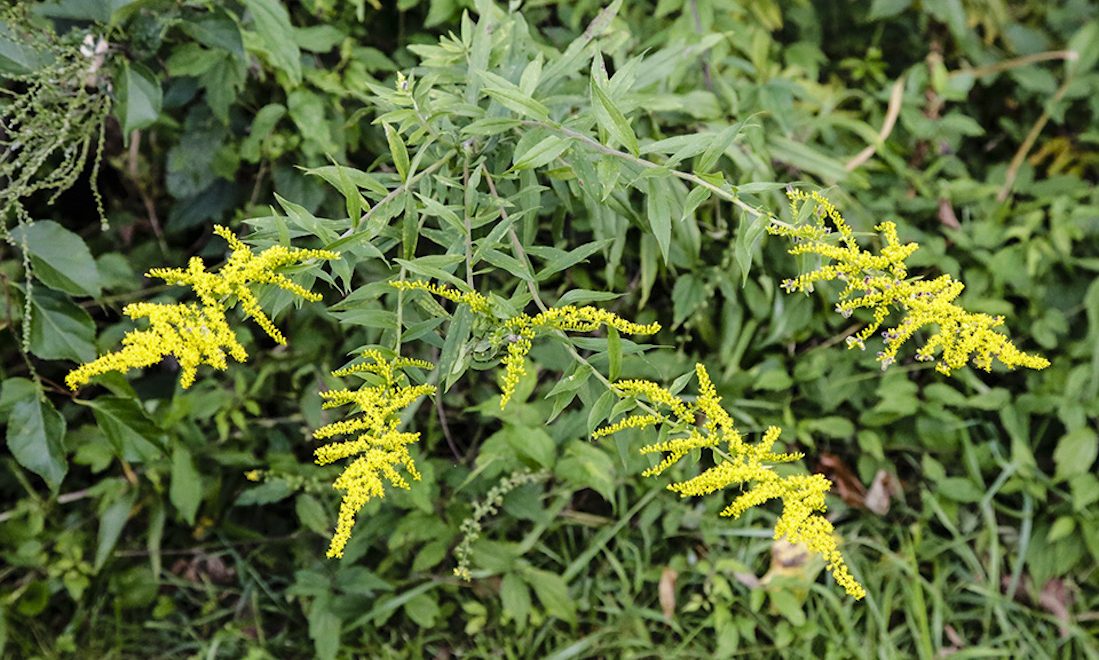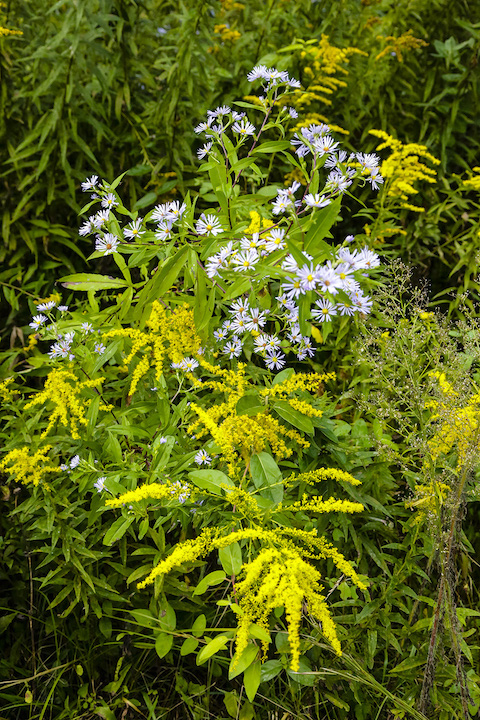“The goldenrods are blooming, so it must be the end of summer.”

Plant of the Month
by Linda Martinson
Blue Ridge Naturalist
The late summer/early fall flowers are bountiful this year because we had plenty of rain through mid-summer followed by ample sunshine into fall. As usual, we can’t miss the goldenrods with their brilliant color! They seem to be blooming along all the roads, in all the ditches and across every meadow, their thick clusters of bright golden flowers waving good-by to summer.
Goldenrods are short-day (i.e., blooming from late summer into fall), native plants of the genus, Solidago, that reproduce through its roots, bulb, stems and by its seeds. There are 120+ species of goldenrods belonging to the aster family, Asteraceae, a large family of tough, herbaceous and adaptable perennial species that spread easily into varied locations—there are even woodland goldenrods—and also crossbreed fairly easily with other plants. Goldenrods are mostly native to North America, including Mexico, but a few species are native to Eurasia and South American. Some species from North America have been introduced to other parts of the world, mostly in Europe.

Goldenrods with the aster cousins.
Goldenrod plants are perennials growing from rhizomes, a continuously growing underground horizontal stem with lateral shoots. Their stems range from growing along the ground to curving upward to standing erect, and vary in height from a few inches to three feet or more, and each individual flower head is about 1/8” long and wide. Most species of goldenrod have several independent horizontal branches, but often the upper part of the plant has multiple attached branches. The stems are characteristically long and woody with widely-spaced clusters of distinctive and rather elegant small yellow flowers that are grouped into complex compound arrangements of blossoms.
Do you think you or someone you know may be allergic to goldenrod or have hay fever from its pollen? Wrong! No one can be allergic to goldenrods because it is pollinated only by insects, so it doesn’t produce too much pollen and what pollen it does produce is too heavy and sticky to be blown away. Goldenrod is often blamed for causing allergies and hay fever because it blooms at the same time as ragweed (Ambrosia sp.) which, because it is a wind-pollinated plant producing excessive light, fly-away pollen, does cause hay fever and other allergic reactions.
Although they are quite common and even invasive in some areas, goldenrods are not to be taken for granted because they are remarkable plants. Not only are the flowers distinctive and showy, all the parts of goldenrod plants that are above ground are edible. The flowers make stand-out garnishes on salads, and the leaves can be used fresh or dried to make tea. The leaves also can be cooked like spinach or added to soups, stir-fry dishes or casseroles.

“Are you sure these goldenrod plants are edible?”
All varieties of goldenrod are not only nutritious but also can be used for many health benefits, not only as fresh or dried herbs in teas, but also as an herbal medicine in an extract, as a tincture, or in capsules. Some Native American cultures used the seeds of some goldenrod species for food; chewed the leaves of goldenrod plants to soothe sore throats; and prepared tonics from the roots to relieve toothaches. Traditionally, one variety of goldenrod in particular (Solidago virgaurea) has been used in a tonic to cleanse the kidneys and bladder during a healing fast and to reduce inflammations caused by kidney stones or bacterial infections.

Among its many other virtues, goldenrod plants are attractive sources of nectar for bees, flies wasps, and butterflies. Honey can be gathered from the bees that collect nectar from stands of goldenrod. If the honey flow is strong, a very light and almost clear mono-floral, spicy honey can be produced. Strangely, the honey from goldenrods has an almost rank smell and taste while it is ripening, although is is quite mild when it is finished. Goldenrod species are also used as a food source by the larvae of many butterfly and moth species.
Although they are considered weeds by many people in North America, in some places goldenrods are considered a sign of good luck and they are prized as garden plants in Europe, for example. In 1895, goldenrod (Solidago gigantea) was chosen as the state flower of Nebraska and also by the state of Kentucky in 1926 and, just recently, by the state of South Carolina. Although the plant is now more accepted as a garden plant in North America, especially the hybrid species, it has become an invasive species in other parts of the world including China.
Finally, don’t forget that goldenrods are stunning cut flowers in arrangements, as filler flowers or on their own. Just as their branches arch and bend elegantly along the side of the roads to show off their plumes of tiny elegant yellow flowers, they will in a vase, too. The big floppy branches of goldenrod arrange themselves easily around other cut flowers or stand out dramatically in every direction just on their own. And they are easy to pick; the stems don’t have to be cut, you can easily snap them off by hand. So go ahead and resolve to make it a Labor Day tradition to pick a large bouquet of dramatic and virtuous goldenrods for your table.
Resources:
ediblewildfoods.com
americanmeadows.com
Wikipedia
Photos by Linda Martinson







39 comments